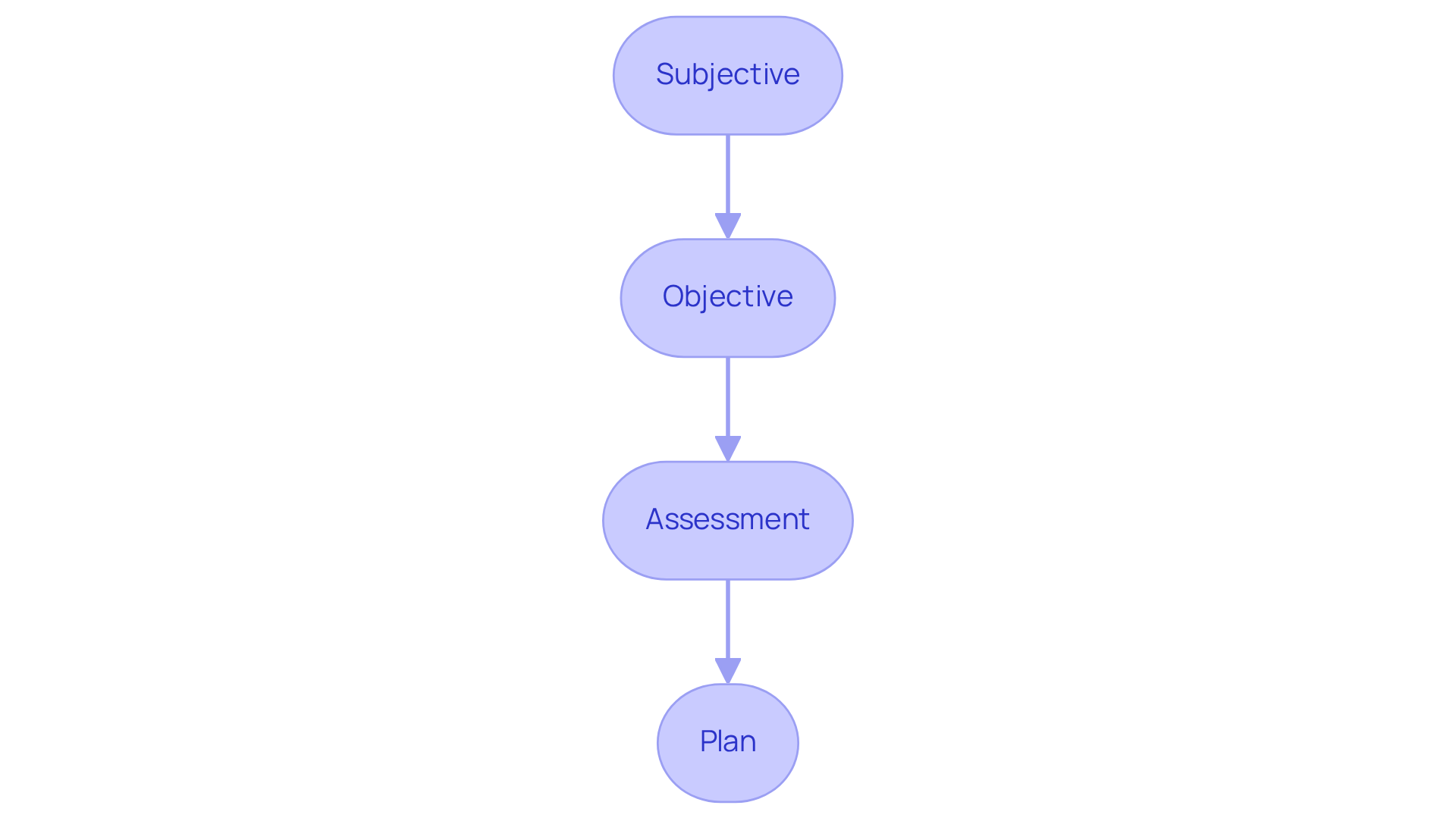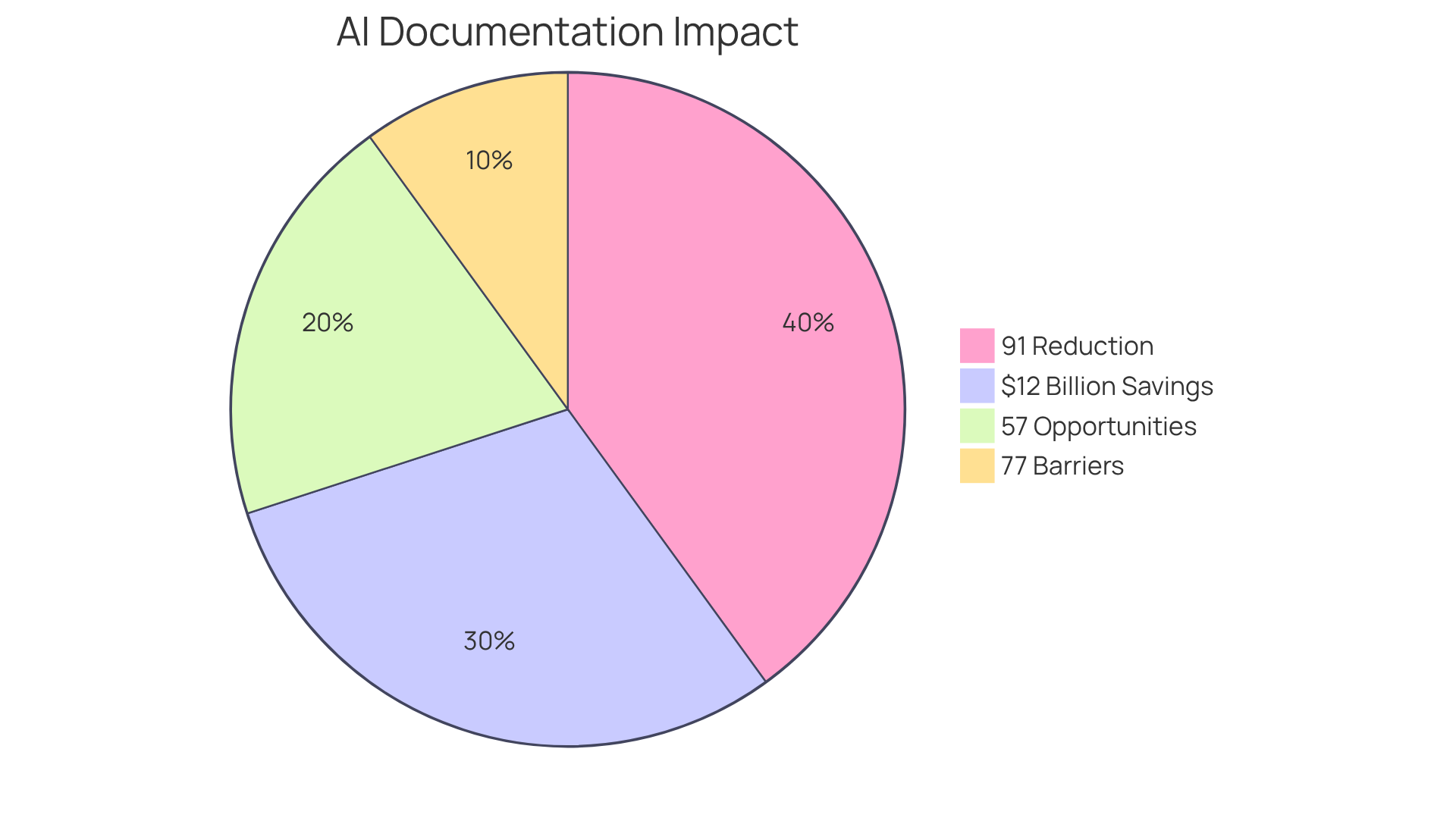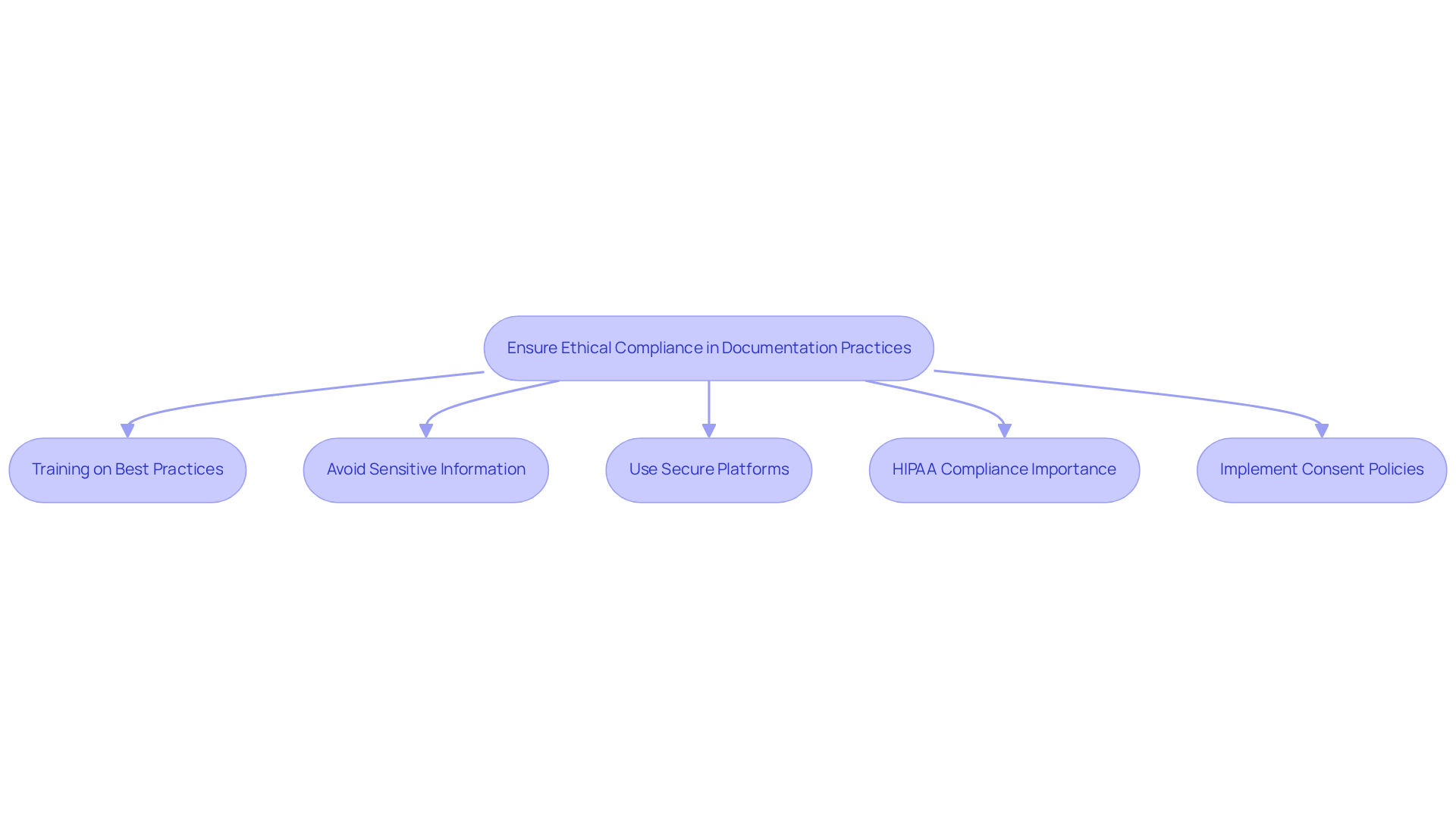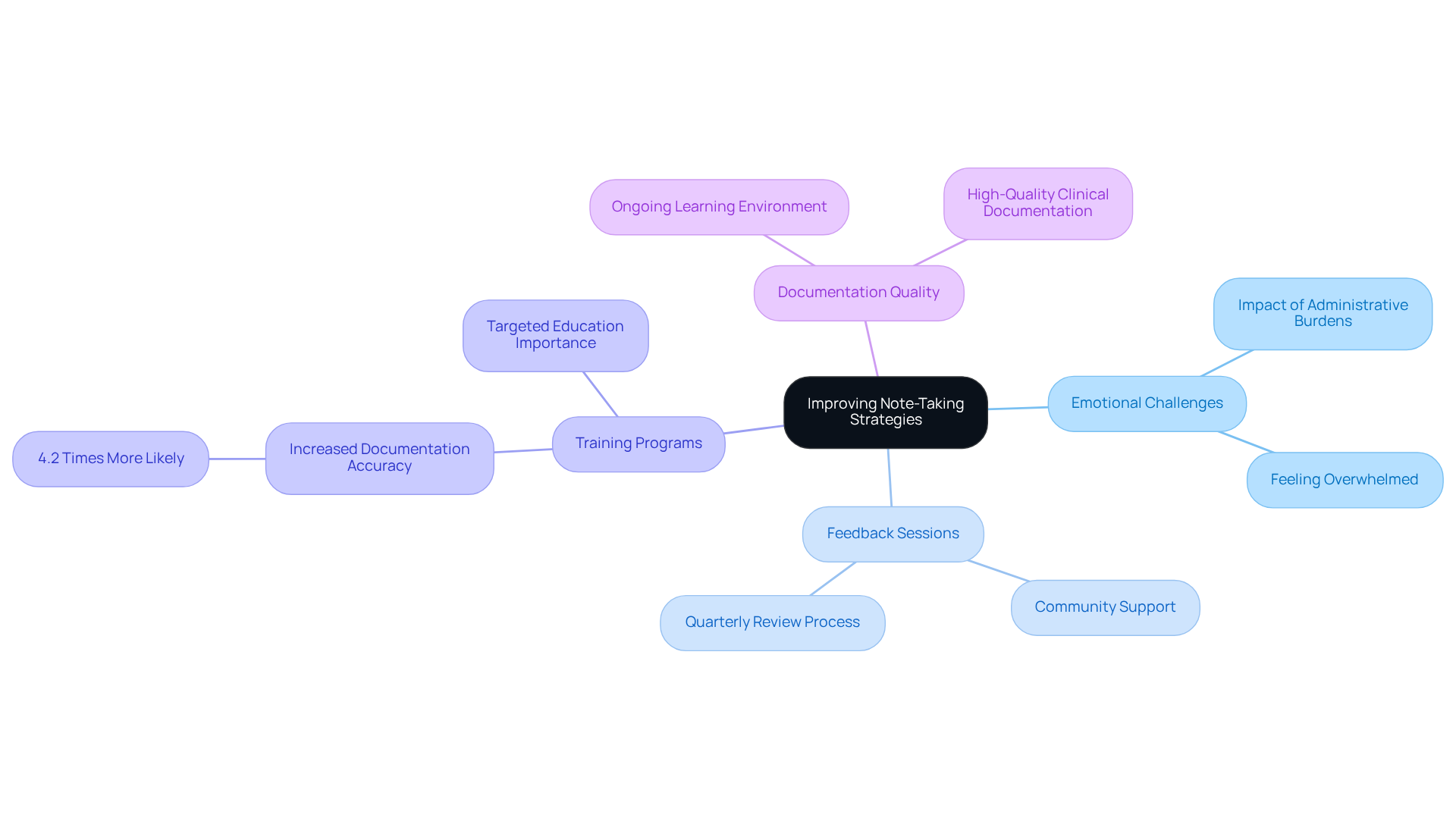Overview
In the demanding world of healthcare, effective medical note-taking is essential for alleviating the administrative burdens that can impact patient care. Structured methods, such as the SOAP format, combined with the innovative use of AI tools for documentation, can significantly ease these challenges. By ensuring ethical compliance and continuously improving our strategies, we can foster a more supportive environment for both providers and patients.
Imagine the relief when clarity and efficiency are enhanced through these approaches. Evidence shows that utilizing AI can lead to a remarkable 91% reduction in processing time, allowing healthcare professionals to focus more on what truly matters—their patients. Organized records not only facilitate better communication but also empower decision-making, ultimately elevating the quality of care provided.
As we reflect on these solutions, it’s important to recognize the emotional and practical benefits they bring. By embracing structured note-taking and innovative tools, we can create a more compassionate healthcare experience. Let’s commit to improving our documentation practices together, ensuring that we prioritize patient care above all else.
Introduction
In the fast-paced realm of healthcare, effective medical documentation is not merely a necessity; it is a vital lifeline for both providers and patients. Many healthcare professionals grapple with the emotional weight of administrative burdens that can detract from patient care. By mastering structured note-taking methods, they can significantly enhance communication, streamline decision-making, and ultimately improve patient outcomes. Yet, amidst the increasing reliance on technology and the pressing need for ethical compliance, how can clinicians ensure that their documentation practices remain both efficient and accurate? This article delves into four key strategies that promise to transform medical note-taking. These strategies will equip healthcare providers with the essential tools they need to navigate the complexities of modern patient care.
Adopt Structured Note-Taking Methods
In the demanding world of healthcare, the clarity and effectiveness of medical documentation can often feel overwhelming. Utilizing structured medical note taking methods, such as the SOAP (Subjective, Objective, Assessment, Plan) format, can profoundly alleviate some of this burden. This systematic approach allows medical providers to classify individual information efficiently, which is vital for tracking progress and treatment results.
Imagine a clinician during a consultation with a client. They can capture subjective complaints in the 'Subjective' section, record vital signs and lab results in the 'Objective' section, provide a diagnosis in the 'Assessment' section, and outline the treatment plan in the 'Plan' section. This organized method of medical note taking not only enhances the quality of records but also fosters better communication among healthcare team members, ultimately leading to improved care outcomes.
Research suggests that organized records can result in a 4% increase in classification precision. This statistic emphasizes the opportunity for enhanced decision-making and care management. Additionally, the clarity offered by the SOAP format can significantly reduce the risk of miscommunication, ensuring that all team members are aligned on care strategies.
By embracing this structured approach, healthcare providers can enhance their medical note taking and improve the overall patient experience. How might adopting the SOAP format transform your practice? Consider exploring this method further to see how it can support you in providing the best possible care.

Leverage AI Tools for Efficient Documentation
AI-driven documentation solutions, such as those from CosmaNeura, are transforming the way healthcare professionals approach medical note taking and manage client notes by addressing the critical challenges identified through thoughtful customer interviews. These innovative tools facilitate real-time transcription during consultations, ensuring that vital information is captured accurately and effortlessly. Imagine being able to condense important elements from interactions, allowing healthcare providers to quickly access crucial details before making clinical decisions.
For instance, during a telehealth session, automatic transcription and summarization empower clinicians to concentrate on client engagement rather than being bogged down by medical note taking. This not only saves valuable time but also elevates the quality of care, providing caregivers with instant access to precise and comprehensive patient information. Practices leveraging AI for document processing have seen an impressive 91% reduction in processing time. Furthermore, voice-enabled clinical documentation is projected to save U.S. medical professionals $12 billion annually by 2027, underscoring the significant impact of AI transcription on clinician efficiency.
Moreover, 57% of physicians acknowledge that alleviating administrative burdens presents a substantial opportunity for AI, showcasing the transformative potential of these tools in streamlining workflows. However, it's important to recognize that 77% of medical systems cite immature AI tools as a barrier to implementation, highlighting the ongoing need for development and support in this area.
By listening to the insights of healthcare professionals, CosmaNeura is committed to enhancing its AI solutions to better meet the evolving demands of the industry. Together, we can navigate these challenges and improve the healthcare experience for both providers and patients.

Ensure Ethical Compliance in Documentation Practices
Healthcare providers often face emotional challenges in their roles, particularly regarding medical note taking of individual information. Upholding ethical standards is crucial in medical note taking, ensuring that all notes are accurate, confidential, and compliant with regulations such as HIPAA. At CosmaNeura, we understand the pressures physicians encounter, which is why we emphasize the significance of empowering them through our AI platform. This innovative tool not only boosts doctor capacity but also enhances the quality of care they can provide.
Training on best practices is essential for maintaining patient privacy. This includes:
- Avoiding the inclusion of sensitive information in shared documents
- Utilizing secure platforms for storing and transmitting patient data
For instance, CosmaNeura offers training modules that focus on efficient medical note taking methods and the use of secure communication tools. Have you considered how these practices can transform your approach to patient care?
The importance of HIPAA compliance cannot be overstated. In 2024, the Office for Civil Rights (OCR) collected over $9.9 million in fines across 22 enforcement actions, highlighting the financial repercussions of violations. By aligning documentation practices with Catholic teachings, as emphasized by CosmaNeura, we reinforce a commitment to ethical care. Implementing policies that ensure consent is obtained before sharing information respects the dignity and autonomy of individuals.
This compassionate approach not only safeguards patient information but also enhances trust in the provider-patient relationship. Ultimately, it leads to improved healthcare outcomes. We invite you to explore how our resources can support you in navigating these challenges, ensuring that you can provide the highest level of care with confidence.

Continuously Improve Note-Taking Strategies
Healthcare professionals often face emotional challenges in their demanding roles. The pressure of administrative burdens can significantly impact patient care, leaving providers feeling overwhelmed. It’s essential to consistently assess and improve medical note taking techniques to effectively incorporate emerging technologies and methodologies.
Organized feedback sessions can be a nurturing space where providers come together to tackle challenges and celebrate achievements in record-keeping practices. For instance, imagine a clinic implementing a quarterly review process to evaluate record quality. This allows staff to share valuable insights on effective strategies and areas for enhancement, fostering a sense of community and support.
Training programs reveal that health professionals who receive targeted education are 4.2 times more likely to document their practices accurately compared to those who do not. This highlights the importance of investing in education to enhance care outcomes. Furthermore, addressing issues such as increased client flow and time constraints is crucial for improving record-keeping practices.
By fostering an environment of ongoing learning and adjustment, healthcare providers can ensure their medical note taking methods remain efficient and contribute significantly to better care results. As emphasized in various studies, "High-quality clinical documentation is crucial for the care of patients." Let’s work together to create a supportive atmosphere that prioritizes both effective documentation and compassionate care.

Conclusion
Implementing effective medical note-taking strategies is essential for enhancing patient care and streamlining healthcare documentation. Have you ever felt overwhelmed by the administrative burdens that can detract from patient interaction? By adopting structured methods like the SOAP format, leveraging AI tools, ensuring ethical compliance, and committing to continuous improvement, healthcare providers can significantly improve their documentation practices. This leads to better outcomes for both patients and practitioners.
Throughout this article, we’ve explored key strategies that highlight the importance of organized and efficient medical note-taking. This structured approach not only aids in clear communication among healthcare teams but also reduces the risk of miscommunication. The integration of AI tools has proven to enhance efficiency, drastically cutting down processing times and allowing clinicians to focus more on what truly matters—patient interaction. Furthermore, ethical compliance in documentation is vital for maintaining patient trust and safeguarding sensitive information.
Ultimately, the journey towards effective medical note-taking is ongoing and requires a commitment to improvement and adaptation. By fostering a culture of feedback and education, healthcare professionals can continuously refine their documentation practices. Embracing these strategies not only enhances the quality of care provided but also empowers clinicians to navigate the complexities of healthcare with confidence. Exploring these methods can pave the way for a more efficient, ethical, and patient-centered approach to medical documentation. Together, let’s commit to transforming our practices for the better.




